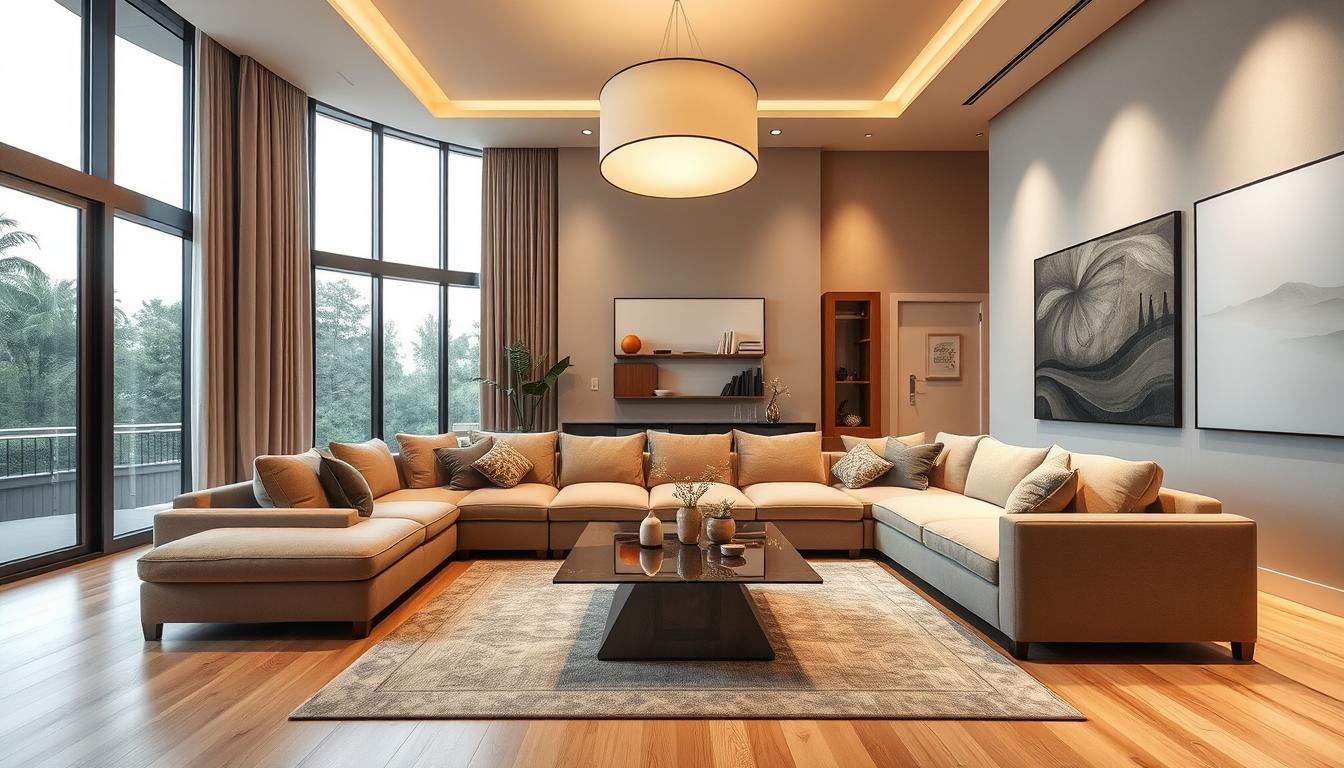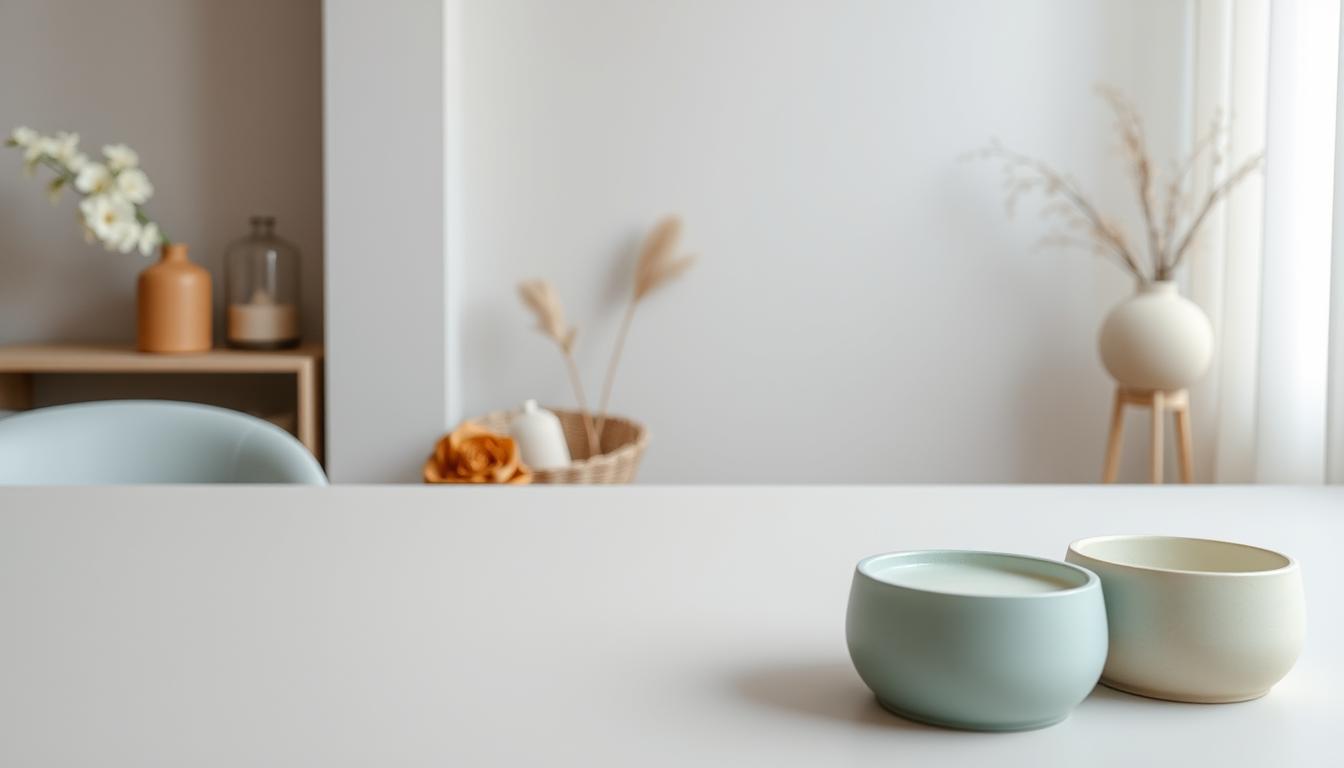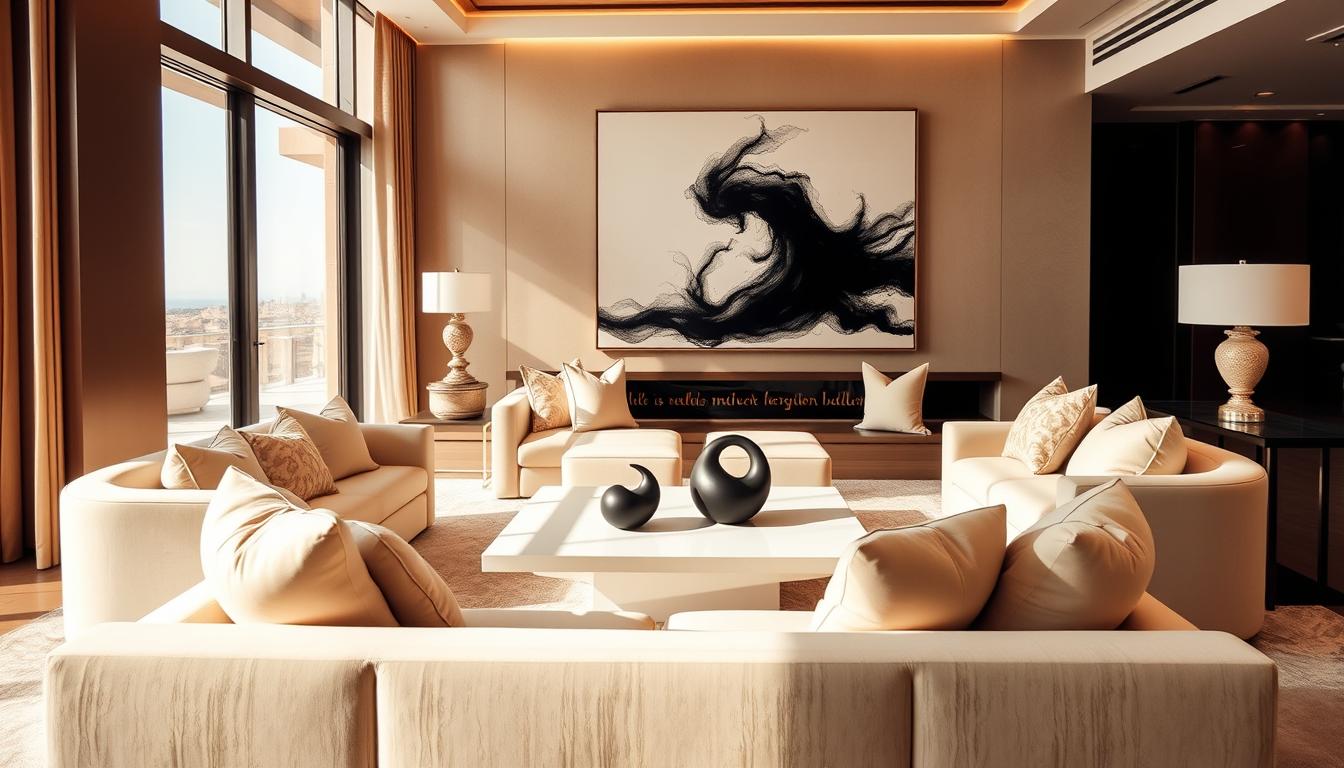Did you know the global interior design market is growing fast? This is because homeowners want to make their living spaces better. With so many styles of home interior design out there, picking the right one can be tough.
At our platform, we know how important it is to have a space that shows who you are. Whether you want to change one room or your whole home, knowing the different design styles is key.
From traditional to contemporary, each style has its own special features. We’ll help you explore the top home interior design styles. This way, you can make choices that make your space both beautiful and useful.
Key Takeaways
- Understanding different home interior design styles
- Characteristics of popular design styles
- Tips for choosing the right style for your space
- Elements that define each design style
- How to create a functional and beautiful home
Understanding Home Interior Design Styles
Interior design styles are key in setting the mood and use of a home. As we dive into home interior design, it’s clear that knowing these styles is crucial. It helps in making a space that looks great and works well.
What is Interior Design?
Interior design is the art and science of making a building’s inside better. It aims to make a space healthier and more beautiful for those who use it. It involves understanding color, texture, and furniture, which shape a room’s look.
Good interior design is more than just looks. It’s about making a space functional and cozy. This means choosing and placing furniture, lighting, and decor thoughtfully.
Importance of Style in Home Design
The style of a home shows the owner’s personality. It greatly affects the feel and function of the space. A good interior design style can make a home feel inviting, modern, or classic, depending on what you want.
Knowing the role of style in home design helps homeowners make better choices. By picking a style that fits their taste, they can make a home that truly reflects them.
Traditional Interior Design: Timeless Elegance
Traditional interior design is all about classic charm and cozy luxury. It takes inspiration from 18th and 19th-century European styles. These elements bring warmth and elegance to any space.
Key Features of Traditional Design
Traditional design stands out with ornate furniture, rich colors, and intricate patterns. Together, they create a classic look that feels both inviting and luxurious.
- Ornate furniture with carved details and luxurious fabrics
- Rich color schemes that include deep reds, blues, and greens
- Intricate patterns such as damask, velvet, and brocade
Experts say, “Traditional design focuses on warmth and comfort. It uses classic elements and luxurious materials.”
“The essence of traditional design lies in its ability to balance elegance with comfort, creating spaces that feel both refined and welcoming.”
Popular Color Palettes
The color palette is key in traditional design. Popular colors include:
| Color | Description | Common Uses |
|---|---|---|
| Deep Reds | Rich, bold, and luxurious | Accent walls, furniture upholstery |
| Navy Blues | Classic and sophisticated | Furniture, drapery |
| Emerald Greens | Vibrant and elegant | Accent pieces, rugs |
These colors, along with neutrals like beige and cream, make up a traditional palette. They help create a warm, inviting atmosphere typical of traditional design.
Contemporary Interior Design: Modern Aesthetics
Contemporary interior design loves clean lines and new materials. It’s great for those who enjoy modern living. This style uses the latest trends and tech to make homes both useful and stylish.
Characteristics and Elements
It focuses on minimalism and functionality. Clean lines, little decoration, and open spaces bring calm and elegance. Neutral colors like whites, blacks, and grays are common. They’re often paired with bold colors for interest.
Innovative materials and technologies are key. This includes smart home tech, green materials, and new furniture designs. The outcome is a space that looks good and works well.
Integrating Technology
Technology is a big part of contemporary design. It includes smart lighting and temperature control systems, and advanced security. The aim is to make living easy and comfortable.
Adding tech in a smart and stylish way lets homeowners enjoy modern life. It’s about making a home that’s both beautiful and practical. This can be through voice assistants or top-notch entertainment systems.
Minimalist Home Design: Less is More
Minimalism in interior design focuses on simplicity and function. It aims to reduce clutter and highlight clean lines and simple colors. This approach makes spaces feel calm and organized.
Core Principles of Minimalism
Minimalist design is all about simplicity, clarity, and function. To get a minimalist look, understanding these principles is key. They help in making your home look clean and organized.
- Simplicity: Minimalist design is simple. It avoids clutter and too much decoration.
- Clean Lines: Clean lines and little decoration are essential in minimalist design.
- Limited Color Palette: A few colors create calm and unity in a minimalist space.
As Mies van der Rohe said, “Less is more.” This quote shows the heart of minimalist design. It highlights the value of simplicity and restraint.
“The ability to simplify means to eliminate the unnecessary so that the necessary may speak.” – Hans Hofmann
How to Achieve a Minimalist Look
To get a minimalist look, design with care and purpose. Here are steps to make your space minimalist:
- Begin by clearing out unnecessary items.
- Choose a few colors and stick to them.
- Go for furniture with clean lines and little decoration.
- Use furniture that does more than one thing to cut down on clutter.
| Design Element | Minimalist Approach |
|---|---|
| Color Palette | Limited to 2-3 colors |
| Furniture | Multi-functional, simple designs |
| Ornamentation | Minimal to none |
By following minimalist design principles, you can make a space that’s both peaceful and useful.
Bohemian Interior Design: Eclectic and Free-Spirited
Bohemian interior design lets you show your personality in your home. It’s great for those who want a space that’s uniquely theirs.
This style mixes vintage and global elements. It’s all about bold colors and patterns. By blending different styles, you can make a space that’s full of life and shows who you are.
Color Schemes and Patterns
Bohemian design is known for its vibrant colors and patterns. You’ll see rich jewel tones, earthy colors, and brights all together. This mix creates a unique look.
- Rich jewel tones like emerald green and sapphire blue
- Earthy hues such as terracotta and sienna
- Bold brights including coral and turquoise
Patterns are also key, with a mix of old and global styles. Think Moroccan tiles and Indian prints. The bohemian style loves combining different patterns and textures.
Incorporating Global Influences
Bohemian design brings global and vintage pieces into your home. You might find African masks or vintage Persian rugs.
| Global Influence | Decorative Elements |
|---|---|
| Moroccan | Intricate tiles, colorful textiles |
| Indian | Vibrant prints, intricately carved furniture |
| African | Masks, tribal patterns, natural fibers |
Adding these elements makes your bohemian space unique and full of character.
Industrial Interior Design: Urban Edge
Industrial design comes from old factories and warehouses. It’s about making new things from old materials. This style is great for those who love the city vibe and want a space that’s both tough and chic.
Materials Commonly Used
Industrial design uses raw, industrial materials. Some common ones are:
- Exposed brick, which adds authenticity and history
- Metal beams and accents, for a rugged feel
- Reclaimed wood, for warmth and character
- Concrete floors, for durability and an industrial look
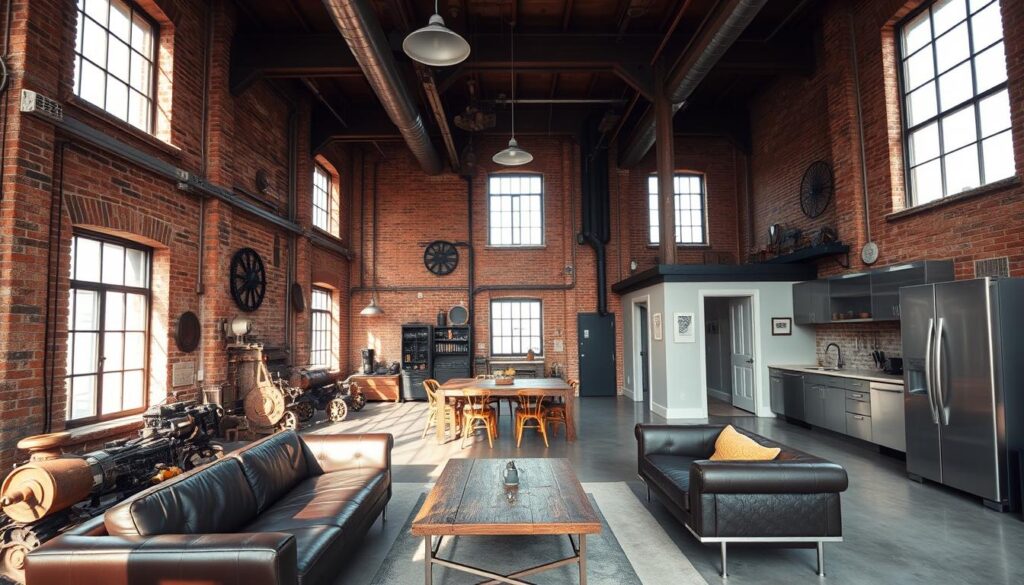
Design Tips for an Industrial Look
To get an industrial look, try these tips:
- Emphasize raw materials: Keep some parts unfinished, like exposed brick or concrete, to show off the industrial look.
- Incorporate vintage and repurposed elements: Old machinery, vintage lights, and reused furniture add character.
- Use a neutral color palette: Stick to gray, black, and brown to keep the look cohesive and true to the style.
- Add metal accents: Metal lights, beams, and decor pieces boost the industrial vibe.
By using these tips, you can make a space that captures the urban edge and elegance of industrial design.
Farmhouse Style: Cozy and Inviting
Farmhouse style is all about creating a warm and welcoming home. It focuses on elements that add comfort and coziness. This design makes any home feel like a cozy retreat.
Key Elements of Farmhouse Design
Farmhouse design often uses rustic wood, vintage decor, and classic patterns. These elements make a space feel inviting and comfortable. Rustic wood adds authenticity, whether on floors, beams, or furniture.
Vintage decor brings history and character to a room. It includes antique furniture, old metalware, and vintage textiles. Classic country patterns like plaids and stripes add warmth and interest.
Modern Farmhouse Trends
Modern farmhouse design blends old and new. It combines industrial elements with traditional styles for a unique look. This mix creates a modern farmhouse that’s both stylish and cozy.
Another trend is using sustainable materials in farmhouse design. Homeowners choose eco-friendly options like reclaimed wood and low-VOC paints. This makes their home environmentally friendly.
“The beauty of farmhouse style lies in its ability to balance old and new, creating a warm and inviting space that feels both timeless and modern.”
By mixing these elements, homeowners can create a cozy farmhouse-style home. It reflects their personal style and taste.
Mid-Century Modern: Retro Charm
Mid-Century Modern style is known for its iconic furniture and bold patterns. It was popular from the 1940s to the 1960s. Today, it still shapes interior design with its focus on function, simplicity, and organic shapes.
Iconic Furniture Pieces
Mid-Century Modern design is famous for its iconic furniture. These pieces are instantly recognizable. Some of the most famous include:
- The Eames Lounge Chair, known for its sleek lines and comfort.
- The Noguchi Coffee Table, which combines simplicity with functionality.
- The Wassily Chair by Marcel Breuer, featuring a tubular steel frame and leather straps.
These pieces add a touch of retro charm. They also bring sophistication and elegance to any room.
Color and Décor Tips
To capture the essence of Mid-Century Modern design, choose the right colors and décor. Here are some tips:
| Color Scheme | Décor Elements |
|---|---|
| Warm neutrals like beige and walnut | Organic shapes and natural materials |
| Bold colors such as turquoise and orange | Graphic patterns and abstract art |
| Earth tones and muted greens | Statement lighting fixtures and sculptural decor |
By mixing these elements, you can create a space that honors Mid-Century Modern style. It will also feel fresh and contemporary.
Key Takeaways: Mid-Century Modern design celebrates retro charm with iconic furniture, bold colors, and graphic patterns. By using these elements, you can make a stylish and nostalgic space.
Scandinavian Design: Simple and Functional
Scandinavian design comes from Nordic countries. It focuses on simplicity, functionality, and minimalism. It’s great for those who like a clean and calm space.
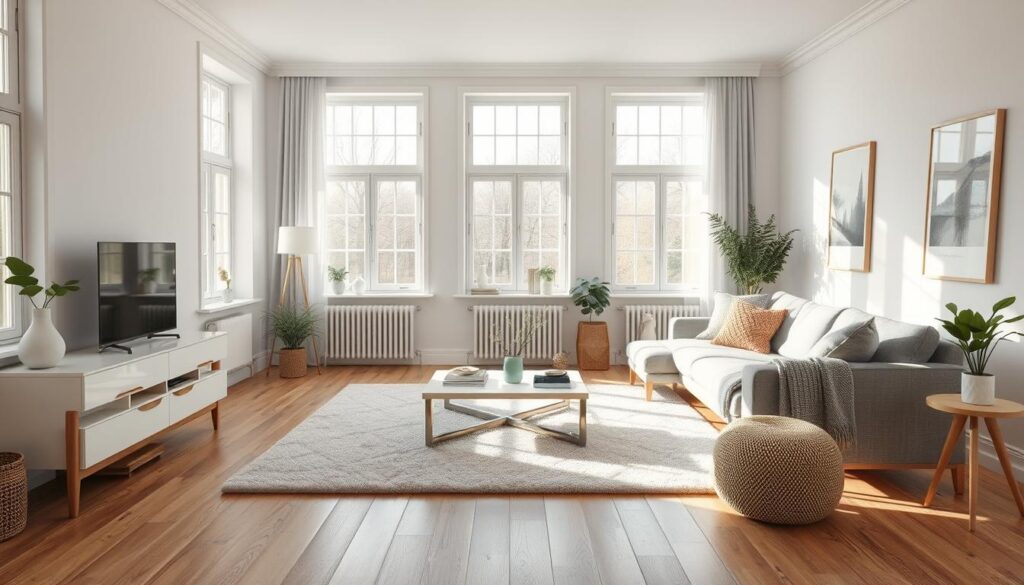
Core Principles
Scandinavian design has key principles for a welcoming space. These include:
- Emphasis on simplicity and minimalism
- Use of light colors to create a bright and airy feel
- Incorporation of natural materials such as wood and wool
- Clean lines and minimal ornamentation
For more insights into Scandinavian interior design, you can visit Architectural Digest. They offer a detailed look at this design style.
Creating a Bright, Open Feel
To make your home bright and open with Scandinavian design, consider these elements:
| Element | Description | Benefits |
|---|---|---|
| Light Colors | Using a palette of whites, creams, and light woods | Creates a sense of spaciousness and brightness |
| Natural Materials | Incorporating wood, wool, and other natural textures | Adds warmth and coziness to the space |
| Minimal Ornamentation | Avoiding clutter and excessive decoration | Promotes a sense of calm and serenity |
By adding these elements, you can make your home look Scandinavian and functional. Start with small changes like light colors and natural materials. This will help you achieve the look you want.
Coastal Style: Relaxed and Breezy
Coastal style is inspired by the sea. It combines nautical elements with a breezy, effortless charm. It’s perfect for those who want to bring the ocean’s tranquility into their homes.
Nautical Colors and Textures
The coastal style features calming colors like blues, whites, and sandy neutrals. These colors remind us of the sea, sand, and sky. Natural materials like wicker, jute, and driftwood add depth and warmth.
Nautical colors include coral pinks and seafoam greens too. These colors add vibrancy. The goal is to keep colors light and airy, making the space feel open and free.
Accessorizing with Coastal Décor
To complete the coastal look, add elements that reflect the sea. Use shells, starfish, and coral in decorative bowls or frames. Nautical artifacts like anchors, ropes, and vintage tools add character.
“The coastal style is all about embracing the beauty of the ocean and bringing it into your home.”
By adding these elements, you can make a coastal space that’s soothing and inviting. It’s perfect for relaxing and unwinding.
Eclectic Design: The Art of Mix and Match
For those who dare to be different, eclectic interior design offers a liberating approach to decorating your home. This style is all about mixing different styles, periods, and textures. It creates a unique space that stands out.
Eclectic design is perfect for individuals who enjoy expressing their personality through their living space. It’s about finding balance and harmony among disparate elements. This can be a fun and creative challenge.
Finding Balance and Harmony
Achieving balance in eclectic design requires a thoughtful approach. Start by selecting a unifying element, like a color scheme or texture. This ties different pieces together, creating a sense of cohesion in the space.
Key tips for balance include:
- Choosing a dominant color and using it throughout the space
- Mixing different textures to add depth and interest
- Balancing bold pieces with more subdued elements
Furniture and Accessory Tips
When it comes to furniture and accessories in eclectic design, the rule is to not follow rules. You can mix vintage and modern pieces, combine different styles, and incorporate unique accessories. This reflects your personality.
Some ideas to consider:
- Pairing a vintage sofa with a modern coffee table
- Incorporating global influences, such as Moroccan tiles or Indian block-print fabrics
- Using statement lighting fixtures to add character
By embracing the eclectic style, you can create a home that is truly one-of-a-kind. It reflects your individuality and personal taste.
Choosing the Right Style for Your Home
Finding the perfect interior design style for your home is all about understanding your space and what you like. It’s about making a place that looks good and feels right, showing off who you are.
Assessing Your Space
Before you start exploring interior design styles, take a good look at your home. Notice its architecture, how much natural light it gets, and how rooms connect. Knowing these things helps pick a style that fits your home well.
Here are some key things to think about:
- The size and scale of your rooms
- The amount of natural light and its impact on your space
- The architectural features of your home
- The flow and functionality of your living areas
By looking at these points, you can find designs that match your home’s layout and features.
Personalizing Your Design Choice
Choosing an interior design style is more than just picking something you like. It’s about making it fit your life and personality. This means adding things that show who you are and what you need.
To make your design personal, think about these:
| Design Element | Considerations |
|---|---|
| Color Scheme | Choose colors that you love and that create the desired mood in your home. |
| Furniture | Select pieces that are not only stylish but also comfortable and functional. |
| Textiles and Patterns | Use textiles and patterns to add depth and personality to your space. |
By carefully looking at your space and making your design choices personal, you can create a home that’s both beautiful and practical. It will show off your unique style and preferences.
Conclusion: The Perfect Style for Every Home
Exploring home interior design styles shows us that the ideal style is personal. It should make your home a sanctuary. Whether you love traditional elegance, modern simplicity, or eclectic flair, the key is finding a style that speaks to you.
Understanding different design styles helps you create a space that shows your personality. It also makes your home a cozy retreat. We suggest trying out various styles until you find the one that feels like home.
The perfect style goes beyond looks; it’s about creating a space that boosts your well-being. As you start your design journey, remember. The most beautiful homes are those that reflect their owners’ unique tastes and needs.

